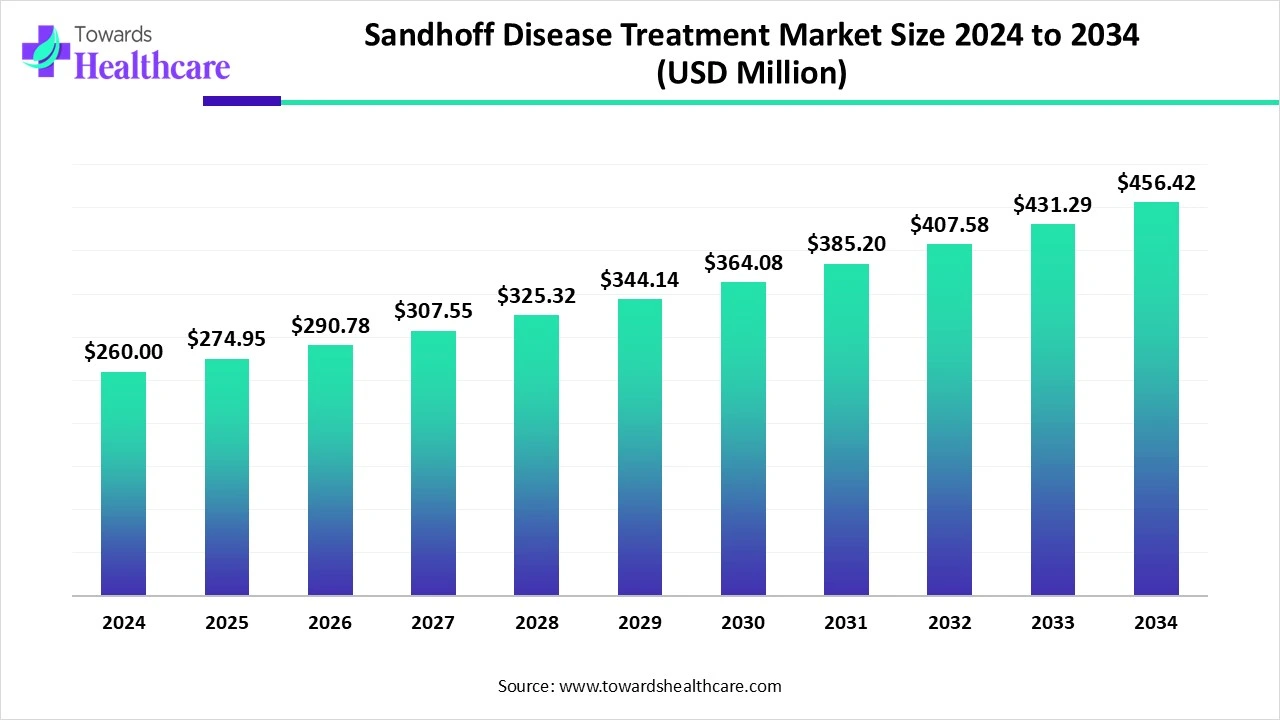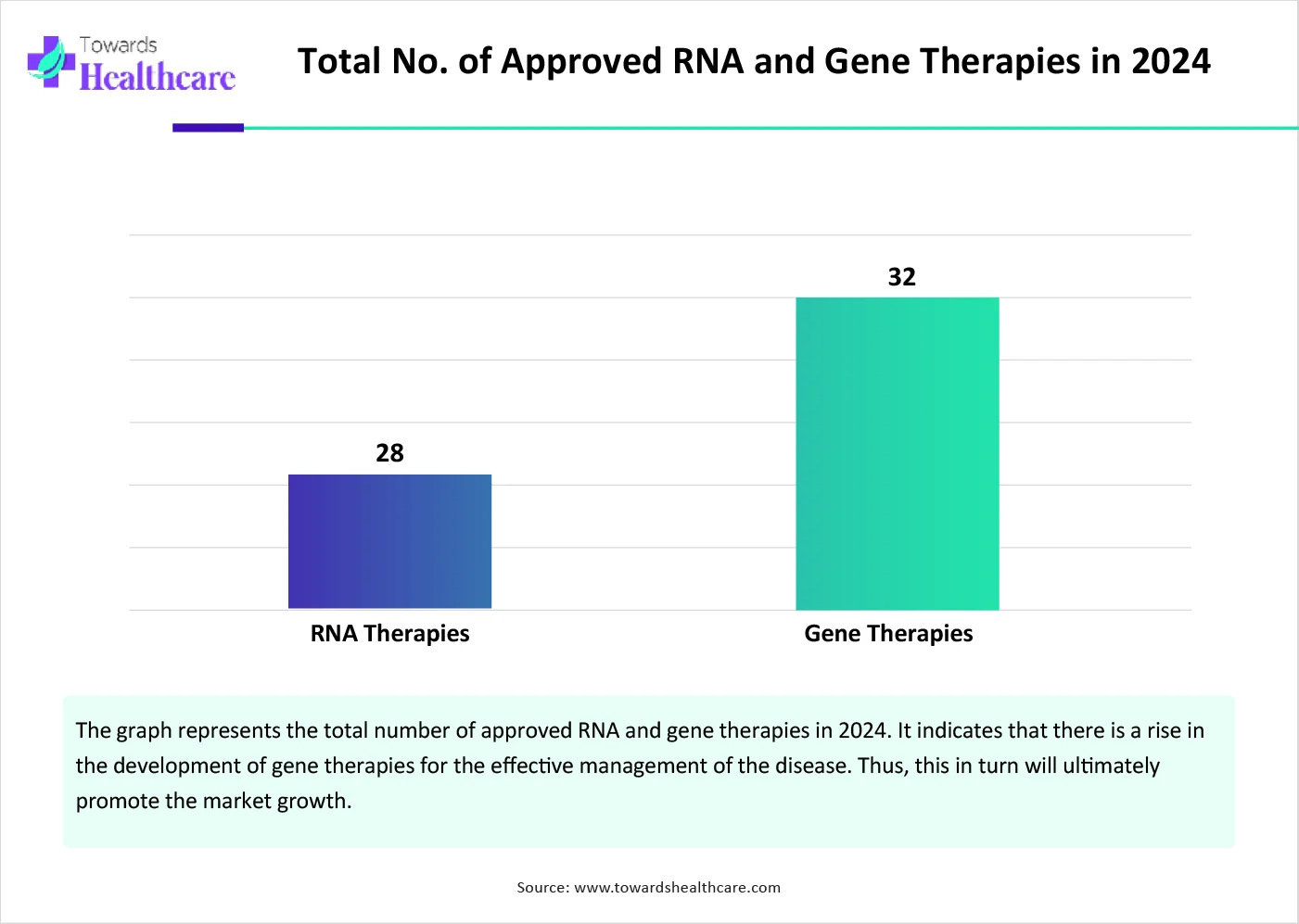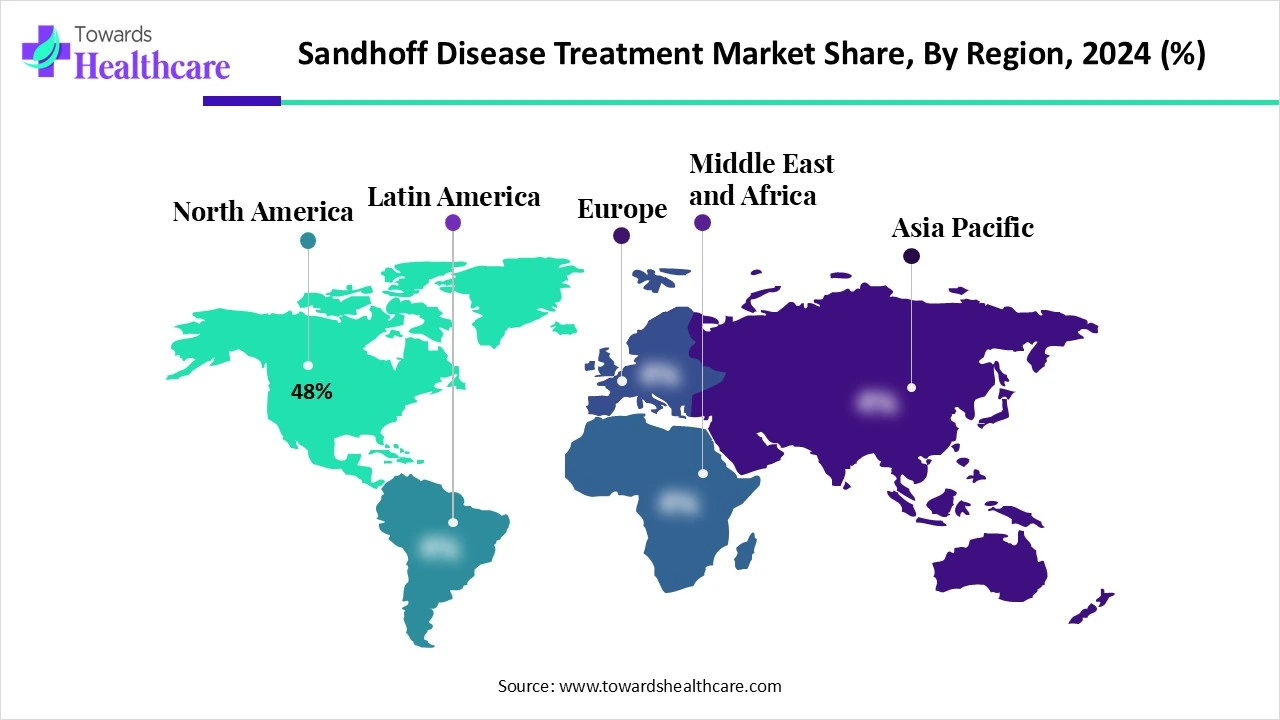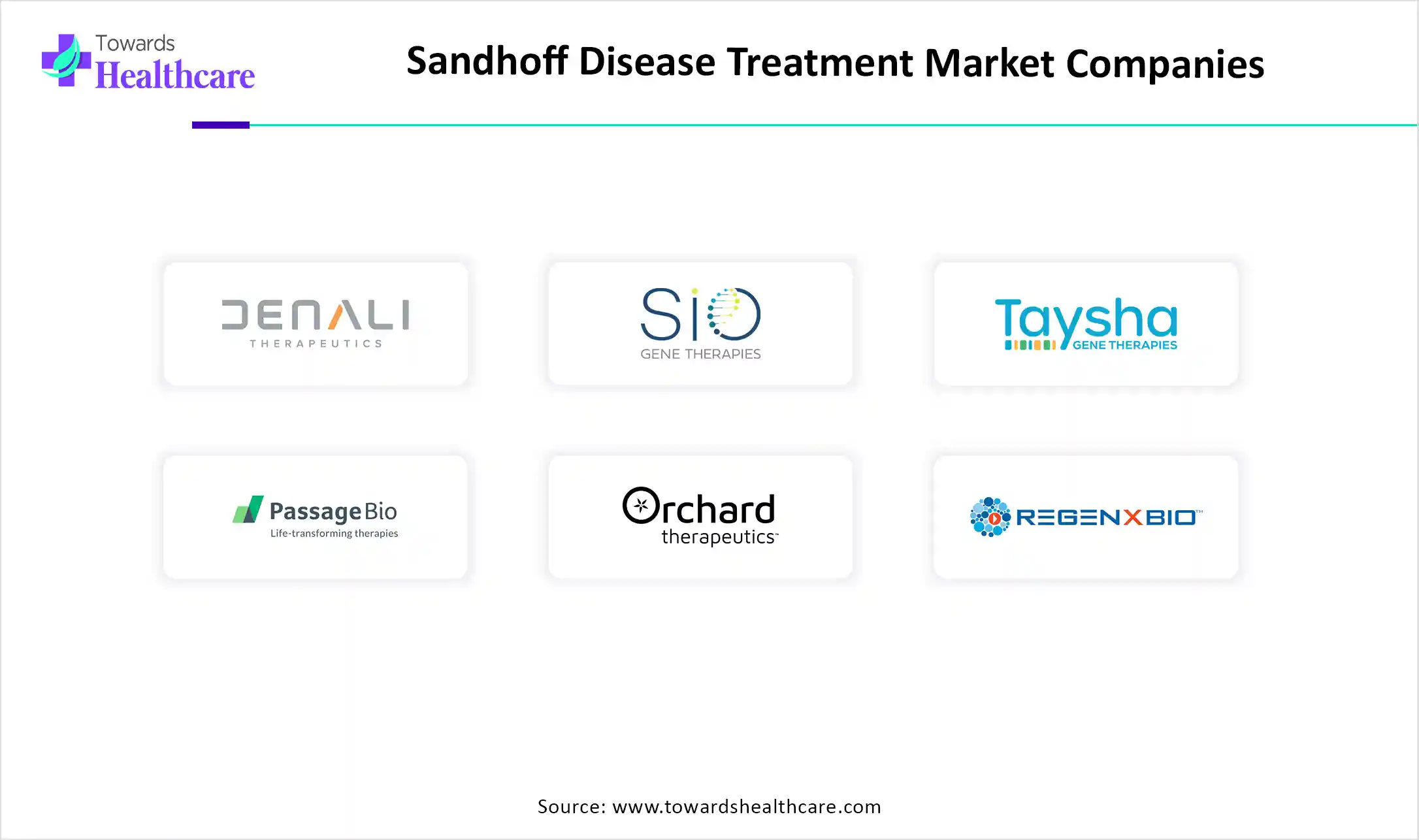November 2025

The global sandhoff disease treatment market size is calculated at US$ 260 in 2024, grew to US$ 274.95 million in 2025, and is projected to reach around US$ 456.42 million by 2034. The market is expanding at a CAGR of 5.75% between 2025 and 2034.
The sandhoff disease is increasing the demand for the use of effective treatment approaches. This, in turn, is increasing the research and development, innovations, as well as investments by the private and government sectors. At the same time, the industries are also utilizing AI to enhance their safety, effectiveness, drug discovery, etc. This is leading to new collaborations, development, and launches of the products. Additionally, their demand in different regions is increasing. Thus, all these factors are promoting the market growth.

| Metric | Details |
| Market Size in 2025 | USD 274.95 Million |
| Projected Market Size in 2034 | USD 456.42 Million |
| CAGR (2025 - 2034) | 5.75% |
| Leading Region | North America share by 48% |
| Market Segmentation | By Therapy Type, By Disease Form, By Drug Type, By End User, By Region |
| Top Key Players | Denali Therapeutics, Sio Gene Therapies (formerly Axovant Gene Therapies), Taysha Gene Therapies, Passage Bio, Orchard Therapeutics, REGENXBIO Inc., uniQure N.V., Sanofi S.A., Johnson & Johnson (Janssen R&D), Takeda Pharmaceutical Company, Novartis AG, Amicus Therapeutics, Biomarin Pharmaceutical Inc., Pfizer Inc. (gene therapy platforms), Genzyme (Sanofi division), Bluebird Bio, Cure Rare Disease (CRD), M6P Therapeutics, IntraBio Inc., National Institutes of Health (NIH) |
The Sandhoff disease treatment market encompasses therapeutic research, development, and palliative care for Sandhoff disease, a rare, autosomal recessive lysosomal storage disorder caused by a deficiency of β-hexosaminidase A and B enzymes. It leads to the accumulation of GM2 gangliosides in neurons, causing progressive neurodegeneration. There is no approved cure currently; however, the market includes supportive therapies, experimental gene therapies, enzyme replacement trials, substrate reduction therapies, and symptomatic management. Growth is driven by orphan drug incentives, rising awareness, and expanding clinical research.
Growing developments in treatment options: The use of supportive therapies is increasing, which in turn is enhancing the development of gene therapies and stem cell therapies for Sandhoff disease. The use of stem cell therapies is increasing as it repairs the neurological damage, while gene therapy restores the enzyme functions.
Increasing research and development: The industries as well as institutions are focusing on identifying the potential targets and are developing various treatment options. Thus, these developments and clinical trials are supported by the government and regulatory bodies for accelerating the trials and approvals.
Growing investments: The growing investment by the government and private sectors in the industries is driving the development of the treatment approaches for Sandhoff disease. At the same time, these investments are being used to reduce the challenges in their development as well as during the trial phases.
A large volume of data can be analyzed effortlessly by the AI. This helps in identifying the drug candidates as well as the targets in Sandhoff disease. It also helps in predicting the immune responses, which in turn helps in selecting a suitable treatment option. At the same time, it is also being used in clinical trials for identifying the onset and progression of the disease, along with its type and severity. Hence, it helps in the development of safe and effective treatment options for Sandhoff disease.
Growing Demand for Treatment Options
Due to limited therapies, the demand for treatment options for Sandhoff disease is increasing. This, in turn, increases the research and development in various industries and institutes. Various oral or intravenous treatment options are being developed by the industry. Similarly, development in stem and gene therapies is also rising. Moreover, the government is also providing its support to increase access to the treatment. At the same time, the regulatory agencies are involved in the faster approval of these approaches. Thus, this is driving the Sandhoff disease treatment market growth.
Low Incidence Rate
The occurrences of Sandhoff disease are very low, which in turn makes it difficult to recruit patients for clinical trials. Thus, this makes it challenging to understand or study the disease and its treatment. Moreover, this affects the development and testing of drugs. This, in turn, decreases the manufacturing and launching of the drugs.
Why is the Growing Awareness an Opportunity in the Sandhoff Disease Treatment Market?
Due to the growing awareness of the Sandhoff disease, there is a rise in the demand for diagnosis and treatment options. The population is shifting towards early diagnosis for enhancing the treatment and reducing the risk of complications of the disease. The use and development of supportive therapies and other next-generation therapies are also increasing. Additionally, the increasing government investment as well as funding are encouraging their development and use. Thus, all these factors are promoting the Sandhoff disease treatment market growth.
For instance,
By therapy type, the supportive & symptomatic treatment segment dominated with 64% share of the market in 2024. The supportive & symptomatic treatments were the preferred choice because there is no approved cure for the disease. At the same time, they helped in minimizing the symptoms and enhancing the mobility of the patients.
By therapy type, the gene therapy segment is expected to show the fastest growth rate at a notable CAGR during the predicted time. The use of gene therapy is increasing as it helps to replace or correct the defective gene, providing long-term effects. Moreover, new innovations are also being made to enhance its applications.

By disease form type, the infantile Sandhoff disease segment held the major share of 71% of the market in 2024. The infantile Sandhoff disease showed faster progression of disease, which in turn, increased the diagnostic rates. Thus, the use of supportive therapies along with their development increased. This contributed to the market growth.
By disease form type, the adult Sandhoff disease segment is expected to show the highest growth during the predicted time. The growing awareness is increasing the diagnosis of adult Sandhoff disease. This is driving the demand for various treatment options and increasing the clinical trials as well.
By drug type, the anticonvulsants & muscle relaxants segment held the largest share in the market in 2024. The anticonvulsants & muscle relaxants were mostly used to deal with the seizures, tremor, or muscle stiffness associated with Sandhoff disease. They were used in all types of Sandhoff disease and were easily accessible and affordable.
By drug type, the experimental gene therapies segment is expected to show the fastest growth rate during the forthcoming years. The use of experimental gene therapies is growing due to their target-specific action. Moreover, research and development are also being conducted, which are funded by the government.
By route of administration, the oral segment led the market in 2024. The oral route was the most preferred route due to its enhanced convenience and non-invasive approach. Moreover, various treatment options were present in oral dosage forms. Thus, this enhanced the market growth.
By route of administration type, the intrathecal/intravenous segment is expected to show the highest growth during the upcoming years. The intrathecal/intravenous route of administration is being used to deliver various gene or enzyme therapies directly to the brain or spinal cord. At the same time, rising severe cases are also increasing their use.
By end user, the hospitals & specialized clinics segment held a 58% dominating share of the market in 2024. The hospitals & specialized clinics consisted of advanced technologies as well as all the facilities that were required for Sandhoff disease patients. Moreover, a wide range of treatments was made available depending on their condition. This promoted the market growth.
By end user, the academic medical centers segment is expected to show the fastest growth rate during the upcoming years. The academic medical centers are researching and developing various diagnostic and treatment approaches for Sandhoff disease. This, in turn, is increasing the clinical trials. To promote these developments, government funding is also provided.

North America dominated the Sandhoff disease treatment market share by 48% in 2024. Due to increasing awareness of Sandhoff disease in North America, various programs and campaigns are being conducted. This is increasing the demand for early diagnosis and treatment options. Thus, this contributed to the market growth.
The industries in the U.S. are developing various diagnostic and treatment approaches to meet the rising demands of the population. At the same time, with the use of advanced technologies, their development is enhanced. Furthermore, the hospital is providing reimbursement policies, enhancing their use.
The growing awareness is increasing the research and development conducted in industries as well as institutes. These are further supported by the government funding as well as investments. Moreover, new collaborations are accelerating the development of advanced gene therapies.
Europe is expected to host the fastest-growing Sandhoff disease treatment market during the forecast period. There is a rise in research and development in Europe, which in turn, is increasing the clinical trials as well. Moreover, to support this development, Horizon funding is also being provided. Thus, this enhances the market growth.
To increase awareness and to track down the Sandhoff disease patients, EU rare disease registries are being established in Germany. At the same time, the government is also investing in companies to enhance the diagnosis, treatment approaches, and research conducted.
The increasing innovations in the UK are leading to a rise in the clinical trials for Sandhoff disease treatments. At the same time, various projects and research are leading to new collaborations among the companies and institutes. These developments are supported by the regulatory agencies.
Asia Pacific is expected to grow significantly in the Sandhoff disease treatment market during the forecast period. The healthcare sector of Asia Pacific is expanding with the adoption of advanced technologies, going into research and development, and increasing investments. Hence, the research, innovation, and investment for Sandhoff disease treatments are also enhanced. Thus, this promotes the market growth.
The industries in China are utilizing advanced technologies, which are helping in predicting the disease progression as well as the drug discovery and development process. Thus, they are focusing on developing new treatment approaches for Sandhoff disease. At the same time, policies are being introduced to enhance these developments.
The growing awareness in India is increasing the demand for and the development of Sandhoff disease treatment and diagnostic approaches. Furthermore, with the help of the investments provided by the government, the development and access to the treatment option are being enhanced by making them affordable.

By Therapy Type
By Disease Form
By Drug Type
By Route of Administration
By End User
By Region
The acne medicine market led the North America due to high acne rates and advancements in treatment in 2023. T...
According to forecasts, the Europe cell and gene therapy market will grow from USD 2.74 billion in 2024 to USD...
Projections indicate that, North America central lab industry is projected to rise from USD 1384 million in 20...
The market is growing due to increasing globalization of trade and rising demand for efficient, technology-dri...
November 2025
November 2025
November 2025
November 2025